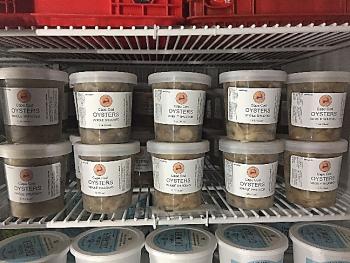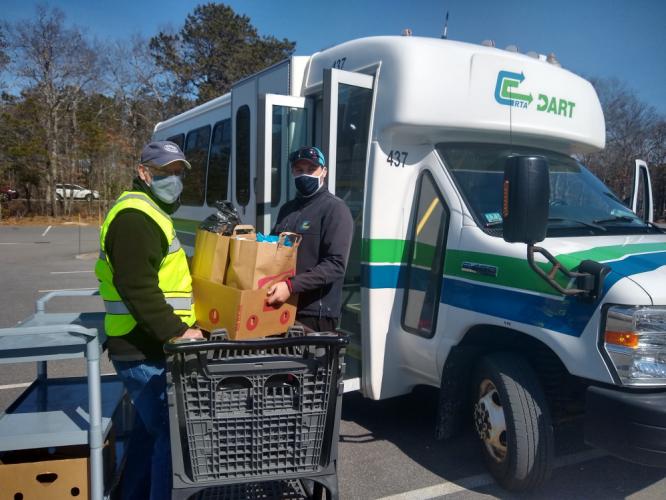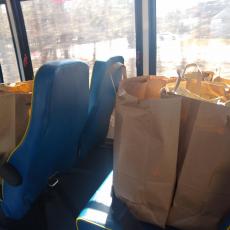In Our Spotlight
Feeding the Hungry in Barnstable County
Call it what you will: lack of food, food scarcity, food insecurity, or just plain hunger. The bottom line is that far too many people don’t have enough food to eat. When the pandemic arrived, food insecurity, already on the rise, took a distressing leap even further upward.
Current Fact: Data from food pantries in Barnstable County, Massachusetts shows the greatest increase in hunger is in the senior population (65+). The percentage of seniors who are hungry has grown to be four times what was reported before the pandemic. In January 2020, 1,945 seniors in the county needed more food. By December, 2020, that number had risen to 8,121.
For those with well-stocked larders or vehicles to retrieve curbside pickups, it may seem unimaginable to have no food, none. Yet this is the case for thousands in our midst. Now consider the challenges of reaching out to find food when your or your children’s bellies are empty and you have no car.
Cape Cod Cooperative Extension Steps Up
Cape Cod Cooperative Extension (CCCE) has always made it a priority to respond to community needs with robust programs. Since the start of the pandemic, county offices received increasing calls looking for guidance about where to find food. Others were looking for the best ways and sites to donate food. Seemingly, everything changed overnight. When it became clear that hunger was taking a dramatic climb, they created a new food access position as part of their nutrition team.
Andrea Marczely was hired as Food Access Coordinator (FAC) for CCCE. The goal of the Barnstable County FAC is to partner with local food distribution entities, as well as local and regional growers and food producers, to address food insecurity needs on Cape Cod and then to streamline existing efforts within the region.
Marczely assesses food security needs in each of the 15 towns of Cape Cod to identify barriers and gaps in access and distribution of food. Through regional collaborations, she works to ensure that all persons on Cape Cod have access to food that is healthy and nutritious. She focuses on linking local producers and distributors with state and federal funding opportunities to maximize efficient distribution of healthy, fresh, and local resources to those in need within Barnstable County.
According to Marczely, the number of people of all ages on Cape Cod who are food insecure has increased by 53% because of the pandemic. This totals 21,097 individuals in 2020, compared to 13,709 in 2019.
Feeding America lists the top four reasons for food insecurity:
• Cost of food: Among people age 65 and older, more than 9% have income below the poverty line.
• Lack of transportation: Older adults often are less mobile or don’t have convenient access to public transportation.
• Isolation: The lack of socialization limits awareness of food programs and other services available.
• Stigma: Many older adults don’t want to be perceived as needing assistance.
Part of what makes food insecurity so difficult to solve is that the underlying causes—poverty, unemployment/underemployment and inconsistent access to enough healthy food – are often deeply interconnected. On Cape Cod, alone, the unemployment rate was nearly three times higher in November 2020 than what is was the year before.
Andrea Marczely, Cape Cod Connector
How does a person become an advocate for the hungry? Marczely worked for many years in business with a strong marketing background. While raising a family, she was employed for nearly a decade for a USDA Child and Adult Care Food Program headquartered in Worcester. Part of the job included teaching family childcare providers about nutrition. Any parent whose children are picky eaters knows how much stress that can create, but Marczely enjoyed focusing on turning stressful mealtime experiences into a positive learning opportunities for both the provider and the children. From there, she supervised the Cape Cod Child Development Child Care program, often meeting with local organizations and getting to know area shelters and service agencies that assisted families. The position of FAC combines Marczely’s interests, background and knowledge. She says, “The job changes every day as I am pulled in different directions, but I find it very satisfying.”
To begin to understand complicated issues of food insecurity, she spoke with many people and organizations to identify common themes. Apparent challenges rose to the top. They included: problems with accessing food due to transportation issues; collaboration with area partners to share knowledge and resources, and communicating with the public on how to access food, volunteer or donate.
Even without a pandemic, transportation is a huge nut to crack on Cape Cod. Without access to a vehicle, it is hard to get to food. A diverse population of immigrants (Brazilian, Haitian, Russian, Jamaican and Cape Verdean) present an array of difficulties around effective communication. Many barriers exist for these groups of people. Better understanding of these cultural barriers or perceptions will enable them to make changes to the food distribution system and educate communities on the resources available to them. A key focus is bringing together leaders from different demographic groups to be part of the food security planning. For example, although many are eager to start gardens, gardening information in various languages is not readily available and culturally-appropriate crops are not easy to find.
Direct and Immediate Teamwork
The challenge of transporting food from one town to another is a considerable issue. Creative thinking resulted in a valuable relationship with Cape Regional Transit Authority (RTA). They stepped right up to answer the call for help. Thomas Cahir, administrator at the transit authority, said, "I am well aware of the seriousness of food insecurity issues here on Cape Cod, so when Andrea reached out to us, we were happy to help. Since the program's launch in January, 2021, our collaboration has led to the completion of over 500 food deliveries." Cahir's team removed some of the seats in smaller buses in order to allow room for food boxes. The RTA donates time, vehicles and carrying heavy food boxes, working with food pantries to deliver food to the most vulnerable 50 people every one-two weeks. Marczely obtains referrals from social service agencies and prioritizes those with the greatest needs. Another important group of players in this new initiative are contact tracers who coordinate with Marczely by email or phone calls to identify urgent needs. Recently, a woman was quarantined in a motel and could not leave, so food was delivered to her by the RTA. In late winter 2020-21, the RTA continues to be a key partner in making food distribution work more effectively. But like most temporary fixes, their availability may change when RTA’s ridership returns to normal.
Where Does This Food Come From?
Most of the food distributed throughout Barnstable County comes from the Greater Boston Food Bank. Many generous local residents have offered to donate food, but because of the pandemic, staffing sites and storing food is more difficult to arrange. Food can be purchased less expensively from the Food Bank, so donors are offering money rather than jars or boxes of food.
Lifting All Boats
 Then there is the gift of the sea. Abigail Archer, Fisheries and Aquaculture specialist at CCCE, secured funding to purchase oysters from Cape Cod growers. They use a processing plant in Chatham where oysters are shucked, frozen and delivered to the Greater Boston Food Bank as well as local food pantries and organizations. Archer works with Marczely to determine which organizations are interested in receiving this donation of shucked oysters. Many restaurants have been closed or working at a reduced capacity since last summer due to the pandemic, so this is yet another valuable collaboration. Coordination of this project though CCCE, helps to provide much-needed income for local growers and healthy local food for those in need.
Then there is the gift of the sea. Abigail Archer, Fisheries and Aquaculture specialist at CCCE, secured funding to purchase oysters from Cape Cod growers. They use a processing plant in Chatham where oysters are shucked, frozen and delivered to the Greater Boston Food Bank as well as local food pantries and organizations. Archer works with Marczely to determine which organizations are interested in receiving this donation of shucked oysters. Many restaurants have been closed or working at a reduced capacity since last summer due to the pandemic, so this is yet another valuable collaboration. Coordination of this project though CCCE, helps to provide much-needed income for local growers and healthy local food for those in need.
Feeding America reports staggering current statistics on old and new faces of hunger:
• Due to the effects of coronavirus pandemic, 50 million people may face hunger in the U.S., including 17 million children.
• Households with children are more likely to experience food insecurity. Before the Covid-19 pandemic, more than 10 million children lived in food-insecure households.
• In 2018, 14.3 million American households were food insecure with limited or uncertain access to enough food.
• Many households that experience food insecurity do not qualify for federal nutrition programs and need to rely on their local food banks and other hunger relief organizations for support.
Marczely was surprised that Barnstable County has the largest percentage of SNAP recipients in the state at 16%, even higher than Boston. She fervently hopes that her work, and that of her colleagues, local farmers and growers is sustainable for the future to provide food access for all.



